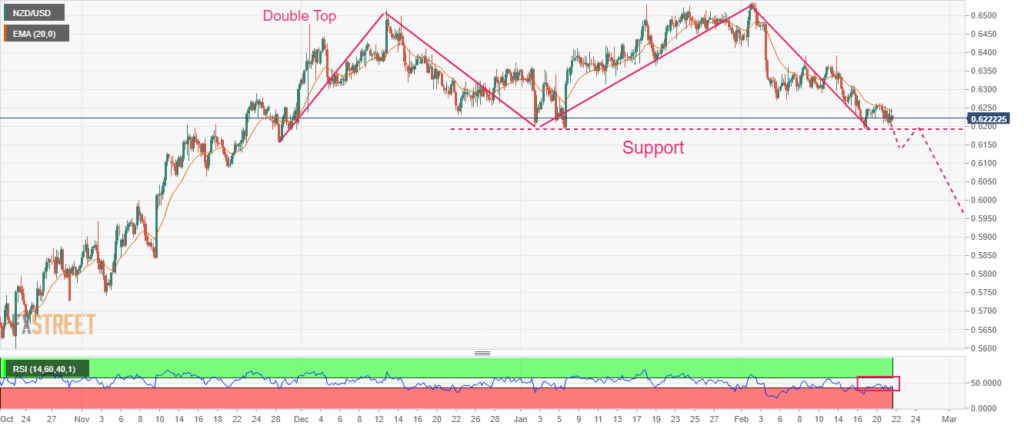Before releasing the Federal Open Market Committee minutes, the NZD/USD exhibits less volatility. US Treasury rates shot up on the rise in the probability that the Federal Reserve would keep tightening its policies.
The Official Cash Rate of the Reserve Bank of New Zealand increased by 50 basis points to 4.75%. NZD/USD may sharply decline after losing the horizontal support indicated by 0.6190. Early in the European session, NZD/USD began to trade sideways at 0.6230 due to erratic swings that indicated the Reserve Bank of New Zealand was adopting a post-hawkish monetary policy (RBNZ). The Federal Open Market Committee (FOMC) minutes, likely to be released in the late New York session, have investors’ attention since volatility in the New Zealand Dollar (NZD) has sharply decreased.
Investors’ capacity for risk-taking gradually increases as risk-sensitive assets rebound after experiencing extreme losses on Tuesday. After the S&P500 futures had their worst day of 2023, they have added some gains. The US Dollar Index (DXY) is moving steadily toward 103.90. The USD index’s lackluster progress might ruin the subsequent upward bias. Investors are anticipated to remain uneasy once the FOMC minutes are released.

US yields reach a three-month high on positive PMI data.
Fears of a recovery in the United States decreasing Consumer Price Index (CPI) were already raised in response to the tight labor market. Monthly solid retail sales data was revealed this month. Also, encouraging early S&P PMI (February) figures have strengthened the argument for a genuine recovery in consumer expenditure. The preliminary S&P Manufacturing PMI (Feb) increased to 47.8 on Tuesday, above both the consensus estimate of 47.3 and the previous report of 46.9. The Services PMI surged to 50.5 versus forecasts of 47.2 and 46.8 in the previous edition.
Investors began speculating that the Federal Reserve (Fed) might consider pausing the current round of policy tightening this month as a result of the contraction in US economic activity over the previous three months. Jerome Powell, the head of the Federal Reserve, repeated that the existing monetary policy should not be paused or reduced since inflation is persistent. The sheer growth of economic activity indicates that the existing monetary policy needs to be more restrained to control persistent inflation.
US Treasury rates shot up on the rise in the probability that the Federal Reserve would keep tightening its policies. The yield on US Treasury notes with a 10-year maturity printed at 3.96%, a new three-month high.
Federal Open Market Committee meeting minutes dominate the attention.
Investors eagerly expect the publication of the FOMC minutes, which will thoroughly justify the Federal Reserve’s 25 basis points (bps) interest rate increase at its February monetary policy meeting. In addition, the minutes will reveal the authorities’ plans for the terminal rate, the inflation objectives set for the current year, and a strategy for meeting the 2% inflation target.
According to Bloomberg, recent calls for another 50 basis-point boost, which should be on the table for future decisions, have come from St. Louis Fed President James Bullard and Cleveland Fed President Loretta Mester. Recession worries in the US may be stoked by a significant consideration for 50 bps increases.
50 bps increase OCR to 4.75% by the Reserve Bank of New Zealand. Because of the strong domestic demand, inflationary pressures in the New Zealand economy have yet to reach their height. Also, Cyclone Gabrielle, widely regarded as the greatest storm, has wreaked such destruction that the price index may continue to rise. The Reserve Bank of New Zealand increased its Official Cash Rate (OCR) by 50 basis points to 4.75% to enhance the monetary instruments in the fight against inflation. Governor of the Reserve Bank of New Zealand Adrian Orr increased interest rates by 75 basis points in November’s monetary policy.
The New Zealand Prime Minister (PM), Chris Hipkins, pledged a cyclone relief package of NZD $300 million ($187.08 million). Thus the Reserve Bank of New Zealand (RBNZ) had previously anticipated a significant rate increase despite the recent release of the helicopter money. Meanwhile, the Reserve Bank of New Zealand’s continued tightening of monetary policy has had disastrous implications on the labor market.
Governor of the Reserve Bank of New Zealand Adrian Orr said unequivocally in the monetary policy statement that the economy would experience a recession in the next nine to twelve months. He said, “To prevent inflation, the central bank promotes saves by raising deposit rates.” The central bank sees no justification for raising inflation objectives.
NZD/USD technical forecast

After establishing a Double Top chart pattern on a four-hour period, which denotes a bearish reversal, NZD/USD has been falling over the previous several weeks. The New Zealand Dollar (NZD) is close to the horizontal support line drawn from the low point on January 6 at 0.6190. The bearish momentum will start if a break is below the aforementioned horizontal support.
The New Zealand Dollar (NZD) is severely restrained by the 20-period Exponential Moving Average (EMA), which is around 0.6242.
The Relative Strength Index (RSI) (14) is now on the edge of entering the negative 20.00-40.00 zone. A downward momentum will start if the same thing happens.

